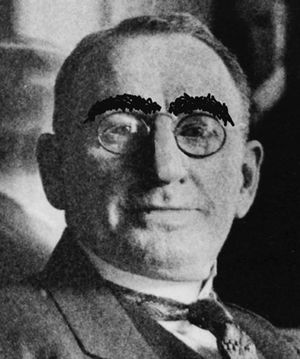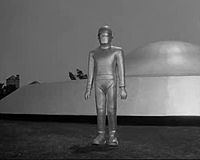Ralph Vaughan Williams
“If Vaughan Williams was any more in love with parallel 5ths, he would marry them, and have a load of little baby parallel 4ths.”
“The greatest composer to emerge out of the hanging baskets of Middle England”
– Sir Charles Villiers Cuthbert Smythe Fortesque Stanford
“He could write a damn good tune, that he could”
“Thanks to Mr. V. Williams, we have an endless supply of soundtracks for programmes about the countryside”
– The BBC
“Music written by a farmer; for farmers”
Ralph Vaughan Williams (known to his friends as Ralph Vaughan Williams), was born with two silver spoons in his mouth in 1722. Williams grew up to be one of the greatest models for grey three-piece suits in England. He also composed one or two symphonies, several string quartets and at least a hundred works for the kazoo, on which he was a famed virtuoso.
Early life and education[edit | edit source]
Ralph Vaughan Williams (pronounced Rafe - his father couldn't say the letter 'l') was born on January 23rd, 1722 in the sleepy village of Birmingham, the son of tailor and part-time lawyer Job Vaughan Williams. Being the youngest of three brothers (his siblings were called Dives and Lazarus), little Ralph had a difficult childhood, not least because his brothers were constantly squabbling over who was going to heaven and who would be damned to hell.
Despite the pressures of family life, Ralph excelled at school, gaining qualifications in Pastoral Studies, Advanced Pastoral Stuides, Modal Harmony, Cream-tea eating, Tailoring and Languages (at the time a course which required students to speak fluently all the languages of the known world). Inspired by his Modal Harmony classes and by his kazoo teacher Mr. William 'Dicky' Byrd, Ralph decided to apply for composition lessons at the Royal College of Music with Professor Sir Charles Villiers Cuthbert Smyth Fortesque Stanford FRCO. However, Stanford turned the young Ralph away, bidding him come back when his musical talent had matured a little more.
So it was that, in 1909, Ralph Vaughan Williams finally began composition lessons. Despite Stanford attempting to crush Ralph's aptitude for modality by a series of punishing hours listening to Diabelli, Spohr and Richard Strauss, the young student's passion for all things Elizabethan remained undiminished. Indeed, it was perhaps the influence of his 'harmony' teacher, Master Thomas Tallis that nurtured this passion.
Vaughan Williams graduated from the Royal College in 1911, when Stanford (perhaps grudgingly) bestowed upon the composer the title quoted above.
First excursions into composition; friendships made[edit | edit source]
It was at this time that Vaughan Williams stumbled across English folksong - a trip that was to transform his compositional outlook. The story goes that Ralph was walking in the countryside when he tripped over an Essex labourer (called Alan Titchmarsh, but known as 'Old George' to his friends) lying in the road who (as was the custom of rural folk in by-gone days) promptly sang a song in apology. Having a piece of manuscript and a walking stick to hand, Ralph prodded the yokel repeatedly until he sang the song again, and was thus able to record it for posterity. However, another account has it that Ralph met 'Old George' in a pub of the same name, and wrote down the labourer's ditty after drinking him under the table and prodding him into submission.
Whatever the details, it is clear that the discovery of folk music had a huge impact on Vaughan Williams' compositional style. In quick succession came his 'Fantasia on English Folk Tunes', his 'English Folk Song Suite', the 'Second Fantasia on English Folk Tunes' and the 'English Folk Song Medley', all of which seem to be based in a clear - yet intangible way - on Folk music.
Around this period (prior to the outbreak of WWI), Vaughan Williams also struck up a friendship with Gustav Holst, another composer concerned with his ethnic roots. The two would go walking in the countryside together, collecting folk songs using any means at their disposal. These included the first recorded use of the I-pod recorder, which had recently been invented by Holst himself.
Indeed it is important to note that Vaughan Williams and Holst were pioneers of recording technology, burning these songs onto CDs which they then sold to the burgeoning scene of folk music fans (without any credit or money payed to the performers).
Mature works[edit | edit source]
Vaughan Williams is perhaps best known for the many folksong based or pastoral/landscape inspired pieces of which the above are examples. Indeed his tone poem 'The Lark Ascending' has made the Classic FM charts. Yet a large portion of the composer's work is gritty and dissonant, no work more so than his recently discovered 'Threnody for Wind Quintet, Anvil and Mixing Desk', an angry, heartfelt lament for the England which Vaughan Williams saw disappearing in a tide of urbanization. The work is the earliest composition to use electronic-acoustic techniques and features the powerful effect of sampled birdsong (in fact a chaffinch) morphing into the sound of a chainsaw, while anvil and squarking clarinets and oboes add a disturbing counterpoint.
Equally experimental is the Phantasy Concerto for Cinema Organ, Rapper, Choir and Orchestra. Here Vaughan Williams pays tribute to two profound influences on his life: the music of early film and seaside amusements, and hip hop. This life-enhancing work intertwines quotations from Eminem and Dr. Dre with excerpts from 1920's hits (complete with a delightful excess of tremulants). Particularly successful is the moment where rapper and choir (accompanied by a battery of percussion and glissando strings) intone the words "Yo blud, I'm gonna blow ya brains out", while the organ plays "Oh, I do like to be beside the seaside."
Symphonies[edit | edit source]
Most crucial to an understanding of Vaughan Williams work are his Symphonies. The composer wrote 400 in total (the last completed on his death bed at the grand old age of 209), each of varying length and scope. Around the 200 mark, the composer was writing for huge forces (Symphony No.211: 'The Amazon' being written for Three Orchestras, Organ, four Soloists, a chorus of parrots, a troupe of trained howler monkeys and a water-machine).
By No.323 'Sahara', we see Vaughan Williams exploring ever more "neo-classical" textures: this work uses a string trio and a lot of sand. A panoply of different themes also exist in these works. What could be more diverse than the experience of eating clotted cream scones explored in the 'Cream Tea Symphony' (No. 83) sitting next to Vaughan Williams' only excursion into 12-tone writing (No.84) or Sinfonia:'Fortnum and Mason' (no. 351) contrasted against the so called 'Iraq War Symphony' (Pastoral Mark 5)? This work was inspired by the composer's own tour of duty in Iraq under Major Gustav Holst.
Controversy[edit | edit source]
Vaughan Williams's trial by Bonn's Beethoven Society in the October of 1938 caused mixed reaction among many observers. On trial for stealing the great composer's ideas, he was released without Charge as part of the Munich Agreement. However, the composer's exposure resulted in his abandoning of so-called 'composing.' He spent the rest of his life doing what he did best - as a copyist.


